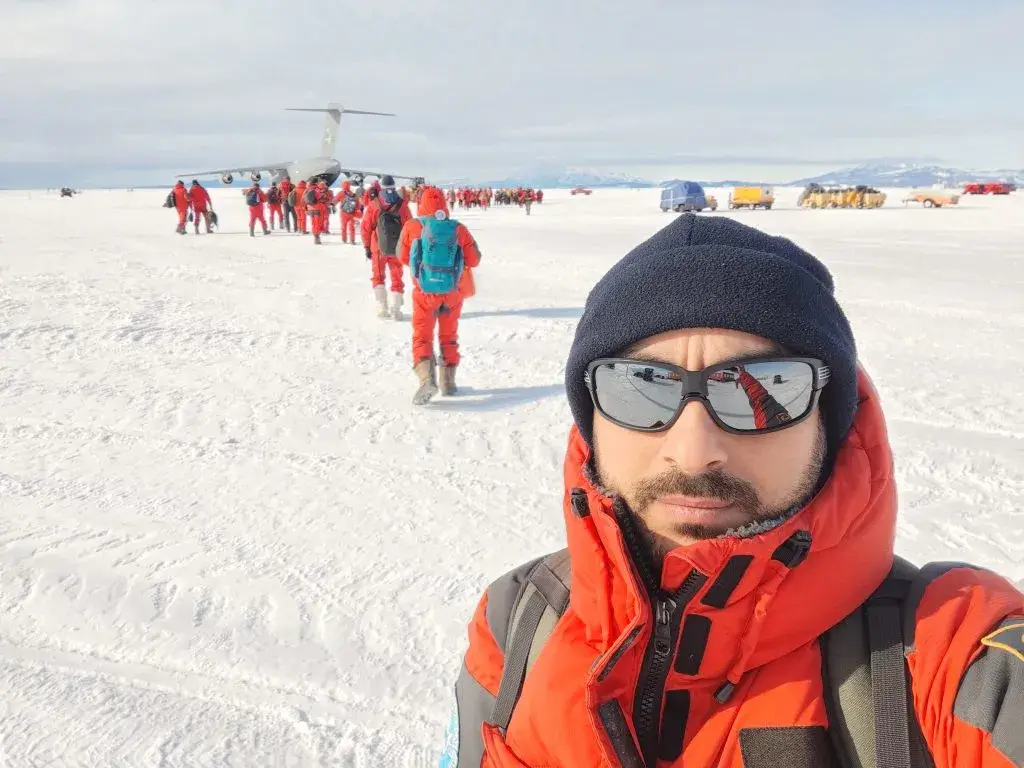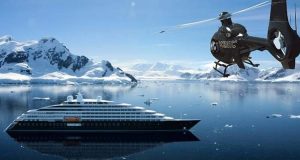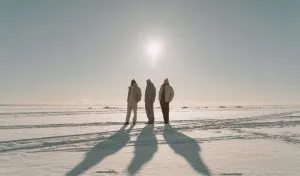In this blog post, we’ll explore the fascinating world of food in Antarctica, answer commonly asked questions like “are there restaurants in Antarctica?”, and share highlights from our exclusive conversation with Luca Ficara, a Sicilian chef working in Antarctica, who’s been serving up dishes for 10 years in what is surely the world’s most isolated kitchen.
In addition to sharing what people currently eat on the continent, we’ll take a look back to the historical diets of brave explorers of yesteryear, and delve into the current regulations and challenges surrounding bringing food to Antarctica.
Food in Antarctica
A History of Food in Antarctica
The history of food in Antarctica is closely intertwined with the heroic expeditions of early explorers. Figures like Sir Ernest Shackleton, Captain Robert Falcon Scott, and Roald Amundsen faced grueling conditions as they pushed the boundaries of human exploration in the early 20th century. There were no in-house Italian chefs back then.
“Breakfast, at 8am, consisted of a pannikin of hot hoosh made from Bovril [a thick and salty meat extract paste] sledging ration, two biscuits, and some lumps of sugar”, Ernest Shackleton wrote in his book published in 1919.
“Lunch came at 1pm, and comprised Bovril sledging ration, eaten raw, and a pannnikin of hot milk for each man. Tea, at 5pm, had the same menu. Then during the night we had a hot drink, generally of milk”.
As you can tell, during these expeditions, the explorers’ diets were dictated by the available resources and technology of the time. They relied heavily on canned and preserved foods, carefully selected for their ability to withstand the harsh conditions and retain their nutritional value over long periods. It was far from gourmet.
Luxurious soggy biscuits
Not everything was protected from the elements, however.
“A few boxes of army biscuits soaked with sea-water were distributed at one meal”, Shackleton wrote.
He continues: “They were in such a state that they would not have been looked at a second time under ordinary circumstances, but to us on a floating lump of ice, over three hundred miles from land, and that quite hypothetical, and with the unplumbed sea beneath us, they were luxuries indeed.”
If you were concerned by the lack of the nutritional value of soggy biscuits, you’ll be glad to know the explorers supplemented their diets with protein from hunting and fishing.
They targeted Antarctic wildlife, including seals and penguins, to acquire fresh meat and blubber. These resources provided much-needed sustenance and essential vitamins and fats, helping the explorers endure the physically demanding expeditions1 (source: https://www.ends-of-earth.com/history/pass-the-penguin/).
What do people living in Antarctica now eat? Does Antarctica have restaurants?
Thankfully, those living and working in Antarctica today have a slightly better diet, although of course there remains unique challenges when it comes to food and there are no conventional restaurants.
The extreme weather conditions and limited availability of fresh produce make conventional diets difficult to sustain. Today, the primary source of sustenance for those residing in Antarctica is the provision of pre-packaged and preserved food.
It’s not all bad, though: some luckier resident scientists at large research stations are provided with chefs who cook up modern comforts like Chinese food, pizzas, and even Yorkshire Puddings. Luca Ficara is one of those chefs – the Sicilian has worked for a decade in Antarctic research stations, and gets creative with the limited ingredients he’s provided with.

How do scientists eat in Antarctica?
Speaking with Polar Guidebook in July 2023, Ficara notes how the food varies across different research stations: at Italian-French run Concordia Station, where he has worked numerous seasons in over the years, he has a well-equipped kitchen and dining area, where scientists and support staff enjoy a mixture of traditional dishes from their respective countries.
In recent years, the French and Italian ingredients are often ordered from Australia and New Zealand, which are the closest countries to the station. Much loved ingredients like Italian hams and tortellini, which are hard to find in these regions, are ordered directly from Italy. But it takes a long time to arrive, Ficara tells Polar Guidebook. Out of your favorite mortadella? Too bad – you’ll be waiting up to 3 months for the next shipment.
In these circumstances, keeping morale high can be tough – but it’s a challenge Ficara is happy to resolve.
“The important thing for me is to give the scientists a taste of home. When spending months on end in Antarctica, the days often feel monotonous and it can be hard mentally – especially in winter. Making French or Italian staples, and of course serving their wines, is a really important way to keep morale up and add some differentiation to the week”.
Luca Ficara, in an interview with Polar Guidebook, July 2023, courtesy of National Antarctic Research Program (Programma Nazionale di Ricerche in Antartide or PNRA) the Italian Antarctic research program.
Another way Ficaro uses food to keep morale high in the station is taking requests: “Sometimes I let scientists request specific dishes. Sometimes they’ll say, “my grandma used to make this – I’m craving it“, and I’ll do my best to recreate it and even invite them into the kitchen to help”.
Can you bring food to Antarctica?
With these unique kitchen challenges, you might be wondering if you can simply pack your own food products when visiting or working in Antarctica. However, bringing food to Antarctica is subject to strict regulations and guidelines to protect the fragile ecosystem and prevent the introduction of invasive species.
The Antarctic Treaty System, an international agreement that governs the continent, strictly regulates the importation of food and other materials. Individuals traveling to Antarctica, whether for research or tourism, must adhere to these regulations.
Generally, personal supplies of food are discouraged, as they can introduce foreign organisms that may disrupt the delicate balance of the Antarctic environment.
Instead, visitors and researchers alike rely on the food provisions available at the research stations or on the vessels that transport them. These regulations ensure the preservation of Antarctica’s unique ecosystem and prevent contamination by foreign organisms.
They also encourage visitors and researchers to experience the unique dining options available on the continent, which offer a glimpse into the challenges and ingenuity required to sustain life in this extreme environment.
What food grows in Antarctica?
Given its harsh climate, limited sunlight, and frozen terrain, plant growth in Antarctica is extremely challenging. There are no native flowering plants on the continent.
However, some research stations have started cultivating small hydroponic systems or greenhouses to grow fresh herbs, leafy greens, and microgreens. These controlled environments provide a limited supply of fresh produce, enhancing the nutritional diversity for station inhabitants.
Engineers at the German Aerospace Center (GAC), for instance, built a greenhouse that can grow vegetables year-round, even in extreme Antarctic conditions. Located at the Neumayer III polar station on the Ekstrom Ice Shelf, the greenhouse uses vertical farming, which involves growing produce on trays under LED lights instead of natural sunlight.2 (source: https://futurism.com/antarctica-is-getting-a-farm-that-can-grow-produce-even-when-its-100-degrees-fahrenheit-outside-take-a-look)
In fact, according to Daniella McCahey, a historian of Antarctic science at Texas Tech University, efforts to grow plants in Antarctica can be traced back to 1902 when British physician and botanist, Reginald Koettlitz, successfully harvested mustard and cress on his expedition’s ship from Antarctic soils. The nutrients from these even managed to fight away an outbreak of scurvy on the ship!
Related questions
How many people live in Antarctica?
Antarctica is primarily a continent dedicated to scientific research, and the number of people living there varies depending on the season. During the summer months, the population can reach around 5,000 individuals, including scientists, support staff, and researchers. However, during the harsh winter season, the population dramatically decreases to around 1,000 people.
Are there restaurants in Antarctica?
While Antarctica does not have traditional restaurants as you would find in urban areas, some research stations do have on-site dining facilities. These facilities cater to the needs of the station’s inhabitants, offering a range of meals prepared by dedicated chefs. The meals are typically made using pre-packaged and preserved food supplies, ensuring sustenance and variety despite the challenging environment.
Where does Antarctica get food?
The majority of food supplies in Antarctica are sourced from outside the continent. These supplies are typically transported to research stations and bases via cargo ships or aircraft. The food is carefully planned and selected to meet the nutritional needs of those living and working in Antarctica. Due to the remote location and limited accessibility, reliance on imported food is necessary to sustain the population.
How is food kept fresh in Antarctica?
Due to the extreme cold temperatures in Antarctica, food preservation is primarily achieved through freezing. Fresh produce, such as fruits and vegetables, is not readily available in Antarctica, so most food items are pre-packaged, canned, or frozen. These preservation methods help maintain the quality and nutritional value of the food while extending its shelf life. Research stations also employ specialized refrigeration and freezing systems to ensure proper storage conditions.
Do they have hotels in Antarctica?
While Antarctica does not have traditional hotels like you would find in other parts of the world, there are accommodations available for visitors and researchers. These accommodations are typically provided by research stations, expedition companies, or cruise ships that operate in the region. They offer various types of lodging, including dormitory-style rooms, cabins, or even tents for those involved in field expeditions. The facilities aim to provide a comfortable and safe stay while visitors and researchers explore the unique wonders of Antarctica.


![Read more about the article How to Visit Antarctica [6 Different Ways to Visit]](https://polarguidebook.com/wp-content/uploads/2022/04/How-to-Visit-Antarctica-300x150.jpg)

